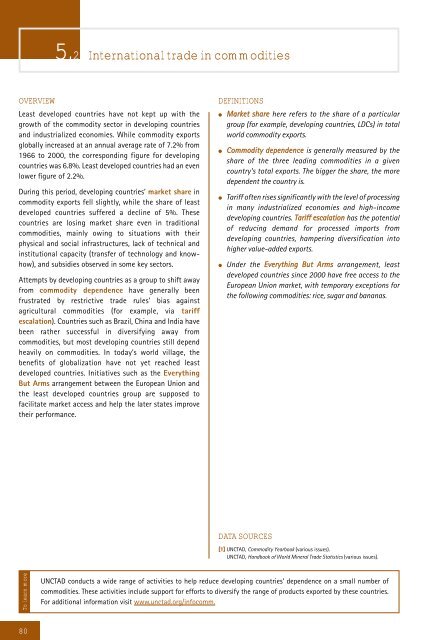Development and Globalization: - Unctad
Development and Globalization: - Unctad
Development and Globalization: - Unctad
You also want an ePaper? Increase the reach of your titles
YUMPU automatically turns print PDFs into web optimized ePapers that Google loves.
80<br />
5.2 International trade in commodities<br />
OVERVIEW DEFINITIONS<br />
Least developed countries have not kept up with the<br />
growth of the commodity sector in developing countries<br />
<strong>and</strong> industrialized economies. While commodity exports<br />
globally increased at an annual average rate of 7.2% from<br />
1966 to 2000, the corresponding figure for developing<br />
countries was 6.8%. Least developed countries had an even<br />
lower figure of 2.2%.<br />
During this period, developing countries’ market share in<br />
commodity exports fell slightly, while the share of least<br />
developed countries suffered a decline of 5%. These<br />
countries are losing market share even in traditional<br />
commodities, mainly owing to situations with their<br />
physical <strong>and</strong> social infrastructures, lack of technical <strong>and</strong><br />
institutional capacity (transfer of technology <strong>and</strong> knowhow),<br />
<strong>and</strong> subsidies observed in some key sectors.<br />
Attempts by developing countries as a group to shift away<br />
from commodity dependence have generally been<br />
frustrated by restrictive trade rules’ bias against<br />
agricultural commodities (for example, via tariff<br />
escalation). Countries such as Brazil, China <strong>and</strong> India have<br />
been rather successful in diversifying away from<br />
commodities, but most developing countries still depend<br />
heavily on commodities. In today’s world village, the<br />
benefits of globalization have not yet reached least<br />
developed countries. Initiatives such as the Everything<br />
But Arms arrangement between the European Union <strong>and</strong><br />
the least developed countries group are supposed to<br />
facilitate market access <strong>and</strong> help the later states improve<br />
their performance.<br />
To learn more<br />
● Market share here refers to the share of a particular<br />
group (for example, developing countries, LDCs) in total<br />
world commodity exports.<br />
● Commodity dependence is generally measured by the<br />
share of the three leading commodities in a given<br />
country’s total exports. The bigger the share, the more<br />
dependent the country is.<br />
● Tariff often rises significantly with the level of processing<br />
in many industrialized economies <strong>and</strong> high-income<br />
developing countries. Tariff escalation has the potential<br />
of reducing dem<strong>and</strong> for processed imports from<br />
developing countries, hampering diversification into<br />
higher value-added exports.<br />
● Under the Everything But Arms arrangement, least<br />
developed countries since 2000 have free access to the<br />
European Union market, with temporary exceptions for<br />
the following commodities: rice, sugar <strong>and</strong> bananas.<br />
DATA SOURCES<br />
[1] UNCTAD, Commodity Yearbook (various issues).<br />
[1] UNCTAD, H<strong>and</strong>book of World Mineral Trade Statistics (various issues).o. 159.<br />
UNCTAD conducts a wide range of activities to help reduce developing countries’ dependence on a small number of<br />
commodities. These activities include support for efforts to diversify the range of products exported by these countries.<br />
For additional information visit www.unctad.org/infocomm.

















